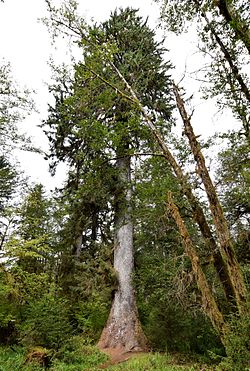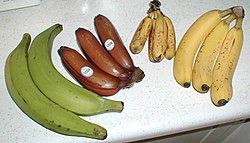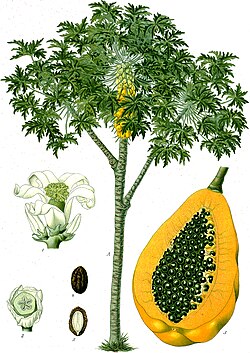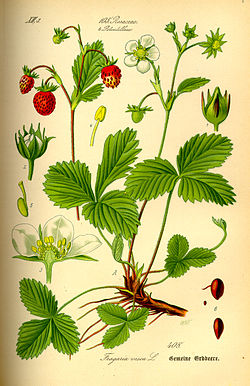Ploidy (/ˈplɔɪdi/) is the number of complete sets of chromosomes in a cell, and hence the number of possible alleles for autosomal and pseudoautosomal...
55 KB (6,193 words) - 23:49, 18 July 2025
The list of organisms by chromosome count describes ploidy or numbers of chromosomes in the cells of various plants, animals, protists, and other living...
101 KB (5,168 words) - 04:51, 18 July 2025
Gene dosage (section Ploidy)
abnormalities). These changes can have significant phenotypic consequences. Ploidy refers to the number of complete sets of chromosomes in a cell. Humans typically...
6 KB (714 words) - 22:53, 3 June 2025
a change of ploidy is involved. To return from a diploid stage to a haploid stage, meiosis must occur. In regard to changes of ploidy, there are three...
25 KB (3,011 words) - 22:54, 1 July 2025
Genomic information NCBI ID 4081 Specimen sequenced Heinz 1706 Ploidy haploid Genome size 827.4 Mb Number of chromosomes 12 Number of genes 31,217 Protein-coding...
78 KB (7,772 words) - 07:34, 19 July 2025
Genomic information NCBI ID 6945 Ploidy diploid Genome size 1,765.38 Mb Number of chromosomes 15 pairs Year of completion 2008...
17 KB (1,719 words) - 18:59, 10 May 2025
Diospyros virginiana (section Ploidy)
Jacob; Berry, Andrew; England, Clifford; Raemakers, Krit (1 January 2020). "Ploidy Level in American Persimmon (Diospyros virginiana) Cultivars". HortScience...
18 KB (2,131 words) - 05:07, 17 July 2025
Azotobacter vinelandii (section Variable ploidy)
PMID 2785985. Maldonado R, Jiménez J, Casadesús J (1994). "Changes of ploidy during the Azotobacter vinelandii growth cycle" (PDF). J. Bacteriol. 176...
5 KB (491 words) - 17:32, 26 January 2025
Taxonomy of wheat (section Ploidy level)
one ploidy level will be more closely related to each other. Ploidy level influences some plant characteristics. For example, higher levels of ploidy tend...
33 KB (2,917 words) - 12:28, 22 July 2025
important plants of the genus Brassica are also tetraploids. Sugarcane can have ploidy levels higher than octaploid. Polyploidization can be a mechanism of sympatric...
81 KB (8,913 words) - 02:40, 9 June 2025
heterozygous. The pairing of chromatids should not be confused with the ploidy of an organism, which is the number of homologous versions of a chromosome...
4 KB (326 words) - 16:13, 28 November 2024
Genomic information NCBI ID 9031 Ploidy diploid Number of chromosomes 78 Year of completion 2012...
35 KB (3,744 words) - 18:57, 22 July 2025
Genomic information NCBI ID 3332 Ploidy 2 Genome size 20 Gbp Number of chromosomes 12 Sequenced organelle plastid and mitochondrion Organelle size 124...
23 KB (2,562 words) - 02:34, 23 July 2025
Scandix pecten-veneris (section Ploidy)
Scandix pecten-veneris (shepherd's-needle, Venus' comb, Stork's needle) is a species of edible plant belonging to the family Apiaceae. It is native to...
10 KB (1,378 words) - 06:46, 29 June 2025
potato, but unlike the potato which is tetraploid, it has several levels of ploidy: diploid, tetraploid, and hexaploid. This species gives its name to the...
2 KB (137 words) - 08:55, 25 September 2023
Genomic information NCBI ID 3659 Ploidy diploid Genome size 323.99 Mb Sequenced organelle mitochondrion Organelle size 244.82 Mb Year of completion 2011...
35 KB (3,486 words) - 21:04, 28 June 2025
Cyanothece is a genus of unicellular, diazotrophic, oxygenic photosynthesizing cyanobacteria. In 1976, Jiří Komárek defined the prokaryotic cyanobacteria...
23 KB (2,459 words) - 13:13, 1 November 2023
Plant development (section Ploidy level)
Important structures in plant development are buds, shoots, roots, leaves, and flowers; plants produce these tissues and structures throughout their life...
44 KB (5,708 words) - 18:29, 1 July 2025
blackthorn such as var. macrocarpa, while the uncertain consequence of the ploidy status of some or all black bullace is absent from research that has focused...
7 KB (956 words) - 18:21, 5 March 2025
Chaerophyllum temulum (section Ploidy)
Wikimedia Commons has media related to Chaerophyllum temulum. Chaerophyllum temulum, the rough chervil, is a species of flowering plant in the family Apiaceae...
7 KB (855 words) - 12:47, 29 July 2024
with high sensitivity. An important use of MLPA is to determine relative ploidy. For example, probes may be designed to target various regions of chromosome...
13 KB (1,654 words) - 08:43, 6 April 2024
Androgenesis (section Ploidy in androgenesis)
Androgenesis is more common in haplodiploid species, (where sex is determined by ploidy such that males generally develop from an unfertilized egg and females from...
21 KB (2,148 words) - 07:37, 8 June 2025
of copies of each chromosome found in that species, also referred to as ploidy. In diploid species like humans, two full sets of chromosomes are present...
23 KB (2,559 words) - 16:29, 19 July 2025
genetic inheritance from the two wild parents and the number of chromosomes (ploidy). Cultivars derived from Musa acuminata are more likely to be used as dessert...
22 KB (2,161 words) - 21:20, 16 July 2025
chromosome and a given allele at that locus A population of N individuals with ploidy n, i.e. an individual carries n copies of each chromosome in their somatic...
8 KB (1,093 words) - 20:35, 18 December 2024
phenomenon of broad taxonomic occurrence, reported for species of different ploidy levels, and for outcrossing and inbreeding, vegetatively and seed propagated...
4 KB (474 words) - 18:42, 26 May 2022
Genomic information NCBI ID 3649 Ploidy diploid Genome size 372 million bp Number of chromosomes 36 Year of completion 2014...
37 KB (3,919 words) - 12:57, 12 July 2025
Genomic information NCBI ID 57918 Ploidy diploid Number of chromosomes 14 Year of completion 2010...
24 KB (2,588 words) - 11:58, 9 June 2025























